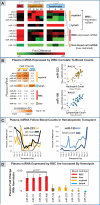Blood cell origin of circulating microRNAs: a cautionary note for cancer biomarker studies
- PMID: 22158052
- PMCID: PMC4186243
- DOI: 10.1158/1940-6207.CAPR-11-0370
Blood cell origin of circulating microRNAs: a cautionary note for cancer biomarker studies
Abstract
Circulating, cell-free microRNAs (miRNAs) hold great promise as a new class of cancer biomarkers due to their surprisingly high stability in plasma, association with disease states, and ease of sensitive measurement. Yet little is known about the origin of circulating miRNAs in either healthy or sick people or what factors influence levels of circulating miRNA biomarkers. Of 79 solid tumor circulating miRNA biomarkers reported in the literature, we found that 58% (46 of 79) are highly expressed in one or more blood cell type. Plasma levels of miRNA biomarkers expressed by myeloid (e.g., miR-223, miR-197, miR-574-3p, and let-7a) and lymphoid (e.g., miR-150) blood cells tightly correlated with corresponding white blood cell counts. Plasma miRNA biomarkers expressed by red blood cells (e.g., miR-486-5p, miR-451, miR-92a, and miR-16) could not be correlated to red cell counts due to limited variation in hematocrit in the cohort studied but were significantly increased in hemolyzed specimens (20- to 30-fold plasma increase; P < 0.0000001). Finally, in a patient undergoing autologous hematopoietic cell transplantation, plasma levels of myeloid- and lymphoid-expressed miRNAs (miR-223 and miR-150, respectively) tracked closely with changes in corresponding blood counts. We present evidence that blood cells are a major contributor to circulating miRNA and that perturbations in blood cell counts and hemolysis can alter plasma miRNA biomarker levels by up to 50-fold. Given that a majority of reported circulating miRNA cancer biomarkers are highly expressed in blood cells, we suggest caution in interpretation of such results as they may reflect a blood cell-based phenomenon rather than a cancer-specific origin.
Figures


References
-
- Chim SS, Shing TK, Hung EC, Leung TY, Lau TK, Chiu RW, et al. Detection and characterization of placental microRNAs in maternal plasma. Clin Chem. 2008;54:482–90. - PubMed
-
- Lawrie CH, Gal S, Dunlop HM, Pushkaran B, Liggins AP, Pulford K, et al. Detection of elevated levels of tumour-associated microRNAs in serum of patients with diffuse large B-cell lymphoma. Br J Haematol. 2008;141:672–5. - PubMed
-
- Chen X, Ba Y, Ma L, Cai X, Yin Y, Wang K, et al. Characterization of microRNAs in serum: a novel class of biomarkers for diagnosis of cancer and other diseases. Cell Res. 2008;18:997–1006. - PubMed
MeSH terms
Substances
Grants and funding
LinkOut - more resources
Full Text Sources
Other Literature Sources
Miscellaneous

